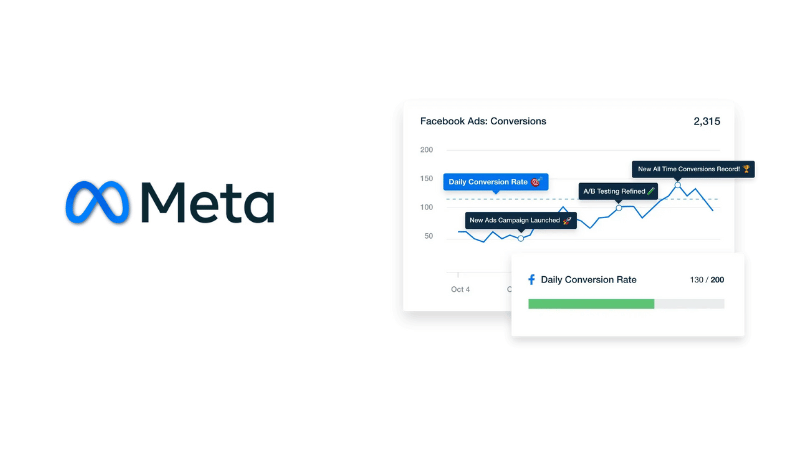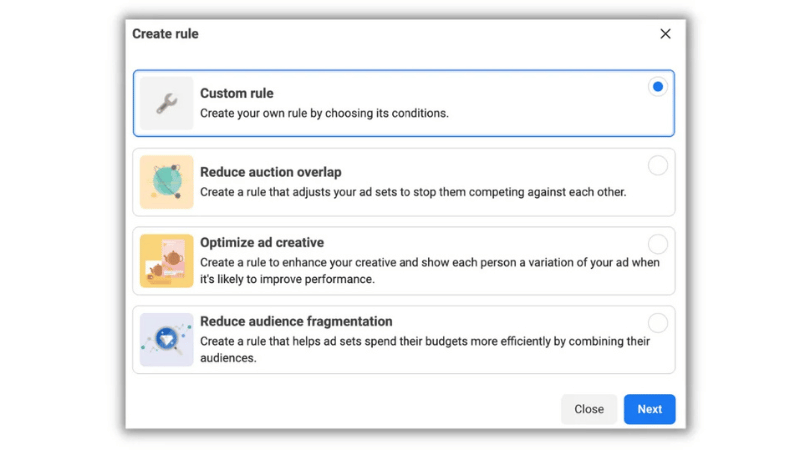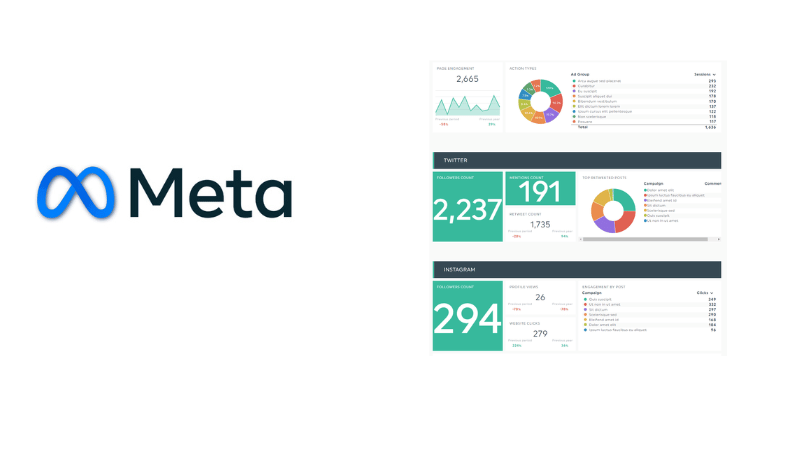Facebook Ad Automation is becoming a key competitive advantage in the world of digital marketing. More than just a trend, Facebook ad automation helps marketers and businesses intelligently optimize campaign performance, save time, and minimize waste. From adjusting the budget in real-time to personalizing content for each audience, applying Meta’s automated tools helps you break through limits and achieve superior results.
Facebook ad automation: Discovering Meta’s power
Manually managing ad campaigns can be time-consuming and effort-intensive. This is where Facebook ad automation proves to be an optimal solution. This concept is not just about scheduling posts, but a comprehensive strategy that helps maximize ad performance, minimize errors, and deliver superior business results.

Definition of Facebook ad automation
Facebook ad automation is the use of tools, algorithms, and preset rules to automatically perform repetitive advertising tasks. Instead of having to manually monitor and adjust a campaign 24/7, you can set rules for the system to automatically change the budget, pause underperforming ads, or adjust the target audience.
This allows you to “set and forget,” letting the system automatically learn and continuously optimize performance. In essence, it turns Meta Ads from a platform that requires continuous human intervention into a smart machine that works effectively even while you are sleeping.
Benefits for Businesses
Instead of spending hours each day monitoring and adjusting each campaign, you can let the automation system do the work. The time saved can be used to focus on more important strategies like content creation, market research, or customer interaction.
Automated rules allow you to quickly pause low-performing ads and increase the budget for ads that are doing well. This ensures that every dollar you spend brings the highest effectiveness, minimizing waste. Meta’s algorithms can also automatically find the most potential audiences, which helps ads reach the right people at the right time.
Unlike humans, automated tools never get tired or take a break. They will continuously monitor and optimize your campaigns day and night, taking advantage of every opportunity to bring results. This is especially important for businesses operating internationally, where time zones are a major challenge.
Automation is not limited to advertising. The use of chatbots or automated response tools on Messenger and Instagram helps businesses respond to customers instantly, answer questions, and even process orders. This creates a seamless and professional experience, which increases customer satisfaction and loyalty.
Humans can make mistakes when entering data or calculating. Automated tools operate based on programmed logic, which significantly reduces unnecessary errors and ensures that the rules are executed accurately and consistently.
Some supporting tools
Automated Rules is a default feature in Facebook’s Ads Manager. You can set up simple rules like: “If the cost per click (CPC) exceeds 5,000 VND, pause the ad,” or “Increase the daily budget by 10% if the cost per acquisition (CPA) is lower than 200,000 VND.”
Advantage+ Campaign is a Meta AI technology that helps automate the entire process from targeting, bidding, to ad display. The system will automatically find the best audience, display the most suitable ad, and allocate the budget optimally to achieve the goal you have set.
Dynamic Ads are extremely useful for e-commerce businesses. They automatically display the most relevant products from your catalog to users who have shown interest. This helps personalize the shopping experience for each customer, just like having a private salesperson for each person.
Chatbots (like Manychat, BotCore) help automate conversations on Messenger and Instagram. You can set up conversation flows to answer frequently asked questions, collect customer information, send discount codes or promotion announcements, and even handle basic orders.
Facebook ad automation rules
Basically, these rules function as a smart management system, allowing you to set specific conditions and actions to automatically adjust a campaign in real-time. In this way, your ads are always operating in the best state, taking advantage of every opportunity and avoiding wasted budget. We can classify these automated rules into different groups, each serving a separate purpose in campaign optimization.

Performance-based rules
Performance-based rules work by continuously monitoring important ad metrics such as Click-Through Rate (CTR), Conversion Rate (CVR), Return on Ad Spend (ROAS), and many other metrics. When these metrics reach a certain threshold that you have set, the system will automatically perform the pre-programmed actions.
If an ad campaign has a high CTR and a good CVR, it proves that your content and objective are on the right track, attracting customer interest. In this case, you can set a rule to automatically increase the budget by 10% to take full advantage of the opportunity to reach more people, scaling the campaign effectively. Conversely, if an ad has a low CTR and a poor CVR, the campaign may not be suitable for the target audience, or the content is not engaging enough.
You can then set a rule to reduce the budget or pause the ad to avoid wasting money on an ineffective campaign, which protects your profits. In addition, this rule can also automatically change the audience: if one audience group does not bring good results, the system can automatically transfer the budget to a more effective audience group that has been pre-determined, which helps you flexibly optimize resource allocation.
Schedule rules
In addition to performance, schedule rules play an equally important role in ensuring your ads run at the right time and in the right place. This type of rule allows you to turn ads on or off at specific times or under certain conditions, ensuring they run during the most effective times of the day or week. When your ads are running, you can use this rule if you want to manage them during peak hours for better interaction or pause them during off-hours to save your budget.
For example, if you find that your ads are not effective at night, when the conversion rate drops sharply and costs increase, you can set a rule to automatically pause the ads from 10 p.m. to 6 a.m. With the “Pause ads from 10 p.m. to 6 a.m.” rule, you ensure your budget is spent at the time when your potential customers are most active and most likely to make a purchase.
Budget-based rules
Another core element of automation is budget-based rules. This rule works by automatically adjusting the budget of a campaign or ad group based on the conditions you set, which helps you manage your spending flexibly and maximize ROI. You can set a rule to automatically stop an ad when it reaches a certain spending level, or to increase/decrease the budget when performance meets a goal.
You should use a budget rule when you want to allocate ad spending to flexibly maximize effectiveness and ROI. This is especially useful when scaling high-performance campaigns or controlling costs for underperforming campaigns.
For example, you have a campaign that always performs well with a high Return on Ad Spend (ROAS). To capitalize on the campaign’s success, you set a rule to increase the campaign’s budget by 10% whenever ROAS exceeds 4, with the automated rule “Increase the daily budget by 10% if ROAS > 4.” This ensures that more resources are directed to high-performance ads, maximizing your profits without the need for manual monitoring and adjustment.
Bidding rules
In a competitive ad market, Facebook Ads Bidding Rules are an indispensable tool for maintaining cost-effectiveness. This rule allows you to automatically adjust bids in ad auctions, which helps you manage bids effectively and ensures that you don’t pay too much for each click or conversion. This is especially useful in competitive ad markets.
For example, if the Cost Per Click (CPC) for your ad increases above $2, you may want to reduce your bid by 5% to control costs and maintain effectiveness. So, you can choose a rule like “Reduce bid by 5% if CPC > $2.” This rule will be automatically triggered when the condition is met, helping you protect your budget from adverse market fluctuations.
Notification rules
Notification rules act as an early warning system, helping you stay on top of the situation of your campaigns without having to constantly check. This rule will send you an alert via email or notification when specific conditions are met, ensuring that you can act quickly when necessary.
For example, when you set the rule “Send an email notification if the daily spend exceeds $500,” if your daily ad spend exceeds $500, the notification rule will immediately send you a warning email. This allows you to quickly review and adjust the budget when needed, preventing unintended overspending. Similarly, you can also receive a notification when the conversion rate suddenly drops or when a campaign is paused, which helps you intervene and fix the problem on time.
Increasing Facebook ad automation performance
Managing ads on Facebook today requires more than just posting and waiting for results. To truly make a breakthrough in sales, a business needs to master how to increase Facebook ad automation performance with smart tools from Meta.

Leverage Dynamic Ads and Advantage+
One of the most powerful tools for automating and improving performance is Dynamic Ads. Instead of having to manually create hundreds of ads for each product, Dynamic Ads will automatically display the right products from your catalog to the right potential customers. This tool works based on user behavior on your website.
Along with Dynamic Ads, Advantage+ is a comprehensive optimization tool that uses artificial intelligence to automate almost the entire advertising process. From targeting to ad distribution, Advantage+ does most of the work for you. It learns from performance data to automatically allocate the budget to the ad groups and ads that bring the best results, which helps maximize Return on Investment (ROI).
Upgrade services with AI bots
Automation is not limited to advertising but also extends to customer service through the use of AI bots. Chatbots integrated with artificial intelligence can change the way a business interacts with customers on Facebook Messenger. These bots can automatically answer frequently asked questions, provide product information, process orders, and even solve basic problems.
Integrating AI bots into your marketing and service strategy helps a business operate 24/7, which provides a fast and seamless customer experience. AI bots can analyze the content of a conversation to understand the user’s intent and provide an appropriate response, or forward the conversation to a support agent when necessary. This helps reduce the workload for the staff while ensuring that all customer questions are answered on time, building trust and satisfaction.
Conclusion
Facebook ad automation is no longer an option but has become a core element for businesses to maintain a competitive advantage. From using automated rules to optimize performance to leveraging the power of AI in dynamic ads and customer service, each tool plays an important role in building a more effective and intelligent marketing strategy. Applying these techniques not only helps you save time and reduce risk but also ensures that all resources are allocated to the right place, maximizing profits.
Frequently Asked Questions
Automated rules allow you to react instantly to market fluctuations, such as increasing bids when there is a sudden spike in demand or reducing spending when effectiveness declines. This ensures that your campaign is always optimized in real-time.
Yes. Advanced rules allow you to automatically increase the budget during peak hours (for example, in the evening or on weekends) and reduce the budget during times of low performance, ensuring that you only spend money when it is most likely to bring the best results.